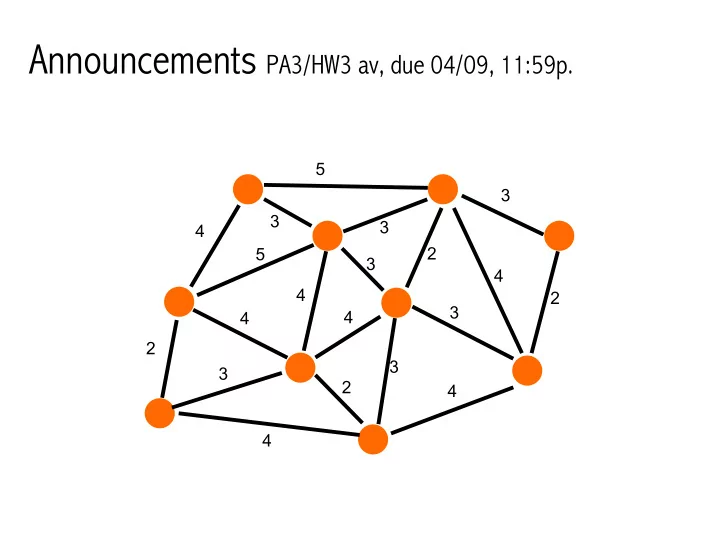

Announcements PA3/HW3 av, due 04/09, 11:59p. 5 3 3 3 4 2 5 3 4 4 2 3 4 4 2 3 3 2 4 4
Prim’s Algorithm (undirected graph with unconstrained edge weights) : Initialize structure: adj mtx adj list 1. For all v, d[v] = “infinity”, p[v] = null 2. Initialize source: d[s] = 0 O(n 2 + m log n) heap O(n log n + m log n) 3. Initialize priority (min) queue 4. Initialize set of labeled vertices to ∅ . Unsorted O(n 2 ) O(n 2 ) array Repeat these steps n times: • Remove minimum d[] unlabeled vertex: v • Label vertex v (set a flag) Which is best? Depends on density of the graph: • For all unlabeled neighbors w of v, Sparse If cost(v,w) < d[w] Dense d[w] = cost(v,w) p[w] = v
Single source shortest path Given a start vertex (source) s, find the path of least total cost from s to every vertex in the graph. Input: directed graph G with non- negative edge weights, and a start vertex s. Output: A subgraph G’ consisting of the shortest (minimum total cost) paths from s to every other vertex in the graph. Dijkstra’s Algorithm (1959) 10 s g 3 c 5 7 7 2 d e 2 3 3 • b f • 6
Single source shortest path (directed graph w non-negative edge weights) : Initialize structure: 10 s 1. For all v, d[v] = “infinity”, p[v] = null g 3 c 2. Initialize source: d[s] = 0 5 7 3. Initialize priority (min) queue 7 d 2 e 3 2 Repeat these steps n times: 3 b f • Find minimum d[] unlabelled vertex: v 6 • Label vertex v • For all unlabelled neighbors w of v, If (_________________ < d[w]) d[w] = ______________ p[w] = v
Single source shortest path (directed graph w non-negative edge weights) : Initialize structure: 1. For all v, d[v] = “infinity”, p[v] = null 2. Initialize source: d[s] = 0 3. Initialize priority (min) queue Repeat these steps n times: • Find minimum d[] unlabelled vertex: v • Label vertex v • For all unlabelled neighbors w of v, If d[v] + cost(v,w) < d[w] d[w] = d[v] + cost(v,w) p[w] = v
Prim’s Algorithm (undirected graph with unconstrained edge weights) : Initialize structure: adj mtx adj list 1. For all v, d[v] = “infinity”, p[v] = null 2. Initialize source: d[s] = 0 O(n 2 + m log n) heap O(n log n + m log n) 3. Initialize priority (min) queue 4. Initialize set of labeled vertices to ∅ . Unsorted O(n 2 ) O(n 2 ) array Repeat these steps n times: • Remove minimum d[] unlabeled vertex: v • Label vertex v (set a flag) Which is best? Depends on density of the graph: • For all unlabeled neighbors w of v, Sparse If d[v] + cost(v,w) < d[w] Dense d[w] = d[v] + cost(v,w) p[w] = v
Dijkstra’s correctness: 1. Assume Dijkstra’s algorithm finds the correct shortest path to the first k vertices it visits (the cloud). … 2. But that it fails on the k+1 st vertex, u. 3. Then there is some other, shorter path from s to u. Call it _____. 4. There must be a node other than u, outside the cloud through which ____ passes. Call it y. 5. The path from s to y is at least as long as the path from s to u, since Q is shortest path out of the cloud. 6. P is even longer!! But that’s a _____________. 7. So our assumption that we failed on the k+1 st vertex is incorrect.
Single source shortest path (directed graph w non-negative edge weights) : Dijkstra’s Algorithm (1959) Why non-negative edge weights?? 10 Initialize structure: a g 13 c 5 Repeat these steps: 7 7 1. Label a new (unlabelled) vertex v, -2 d whose shortest distance has been e found 2 3 2 b s 2. Update v’s neighbors with an improved distance 6
Recommend
More recommend